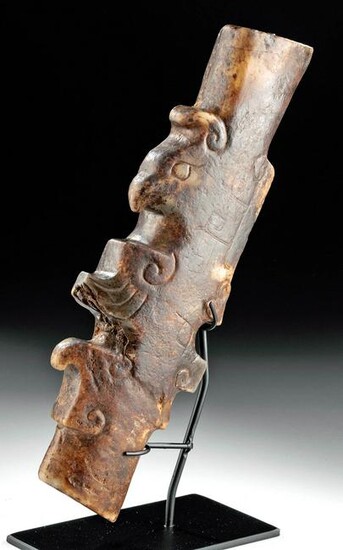Chinese Shang Dynasty Nephrite Carving w/ Birds
East Asia, China, Shang Dynasty, ca. 1558 to 1046 BCE. An intriguing hand-carved nephrite sculpture, of a tall form with a bulbous rectangular body and slanted top and bottom faces. The body bears intricately incised spirals and curvilinear motifs, a couple of rounded squares, and a slender bar protruding from the verso. Depicted on the front is an abstract bird head with recessed circular eyes, an aquiline beak, curled wing feathers, a singular talon protruding on the bottom, and a projecting feathered crest atop the head. Each of the slanted tabs on the top and bottom has a trio of shallow drilled attachment holes, perhaps for attaching the carving to a necklace as a funerary offering or for mounting atop a pole as an elaborate standard. A wonderful example from Shang Dynasty China! Size: 3.625" W x 11.25" H (9.2 cm x 28.6 cm); 10.8" H (27.4 cm) on included custom stand.
Chinese art has incorporated jade since the Neolithic period; quarries for nephrite, the type of jade found in China, have been found in modern-day southern Mongolia that date to ca. 4000 BCE. The stone was prized for its hardness, its beautiful coloration, and its durability. Jade was the most valuable item known to the Neolithic Chinese and was associated with the most important rituals of life. Yu, the Chinese word for jade, is also an idea - of a steadfastness, and reliability, mirrored in the abrasion techniques required to make these intricate works of art. Yu is also not bound by the mineralogical definition of jade - over the millennia that it has been carved in China, the people have had varying access to sources of jade/nephrite - but is rather a wider term for hard stone. By the third millennium BCE, we know that jade had also come to be associated with immortality.
Provenance: private Glorieta, New Mexico, USA collection, purchased at the Great Southwestern Antique Show in Albuquerque, New Mexico, USA in 2019
All items legal to buy/sell under U.S. Statute covering cultural patrimony Code 2600, CHAPTER 14, and are guaranteed to be as described or your money back.
A Certificate of Authenticity will accompany all winning bids.
We ship worldwide to most countries and handle all shipping in-house for your convenience.
#148953
Condition Report: Chips to body as well as top and bottom tabs, with softening to some incised details, darkening to surface color commensurate with age, and light encrustations. Light earthen deposits throughout.
View it on
Sale price
Estimate
Time, Location
Auction House
East Asia, China, Shang Dynasty, ca. 1558 to 1046 BCE. An intriguing hand-carved nephrite sculpture, of a tall form with a bulbous rectangular body and slanted top and bottom faces. The body bears intricately incised spirals and curvilinear motifs, a couple of rounded squares, and a slender bar protruding from the verso. Depicted on the front is an abstract bird head with recessed circular eyes, an aquiline beak, curled wing feathers, a singular talon protruding on the bottom, and a projecting feathered crest atop the head. Each of the slanted tabs on the top and bottom has a trio of shallow drilled attachment holes, perhaps for attaching the carving to a necklace as a funerary offering or for mounting atop a pole as an elaborate standard. A wonderful example from Shang Dynasty China! Size: 3.625" W x 11.25" H (9.2 cm x 28.6 cm); 10.8" H (27.4 cm) on included custom stand.
Chinese art has incorporated jade since the Neolithic period; quarries for nephrite, the type of jade found in China, have been found in modern-day southern Mongolia that date to ca. 4000 BCE. The stone was prized for its hardness, its beautiful coloration, and its durability. Jade was the most valuable item known to the Neolithic Chinese and was associated with the most important rituals of life. Yu, the Chinese word for jade, is also an idea - of a steadfastness, and reliability, mirrored in the abrasion techniques required to make these intricate works of art. Yu is also not bound by the mineralogical definition of jade - over the millennia that it has been carved in China, the people have had varying access to sources of jade/nephrite - but is rather a wider term for hard stone. By the third millennium BCE, we know that jade had also come to be associated with immortality.
Provenance: private Glorieta, New Mexico, USA collection, purchased at the Great Southwestern Antique Show in Albuquerque, New Mexico, USA in 2019
All items legal to buy/sell under U.S. Statute covering cultural patrimony Code 2600, CHAPTER 14, and are guaranteed to be as described or your money back.
A Certificate of Authenticity will accompany all winning bids.
We ship worldwide to most countries and handle all shipping in-house for your convenience.
#148953
Condition Report: Chips to body as well as top and bottom tabs, with softening to some incised details, darkening to surface color commensurate with age, and light encrustations. Light earthen deposits throughout.



